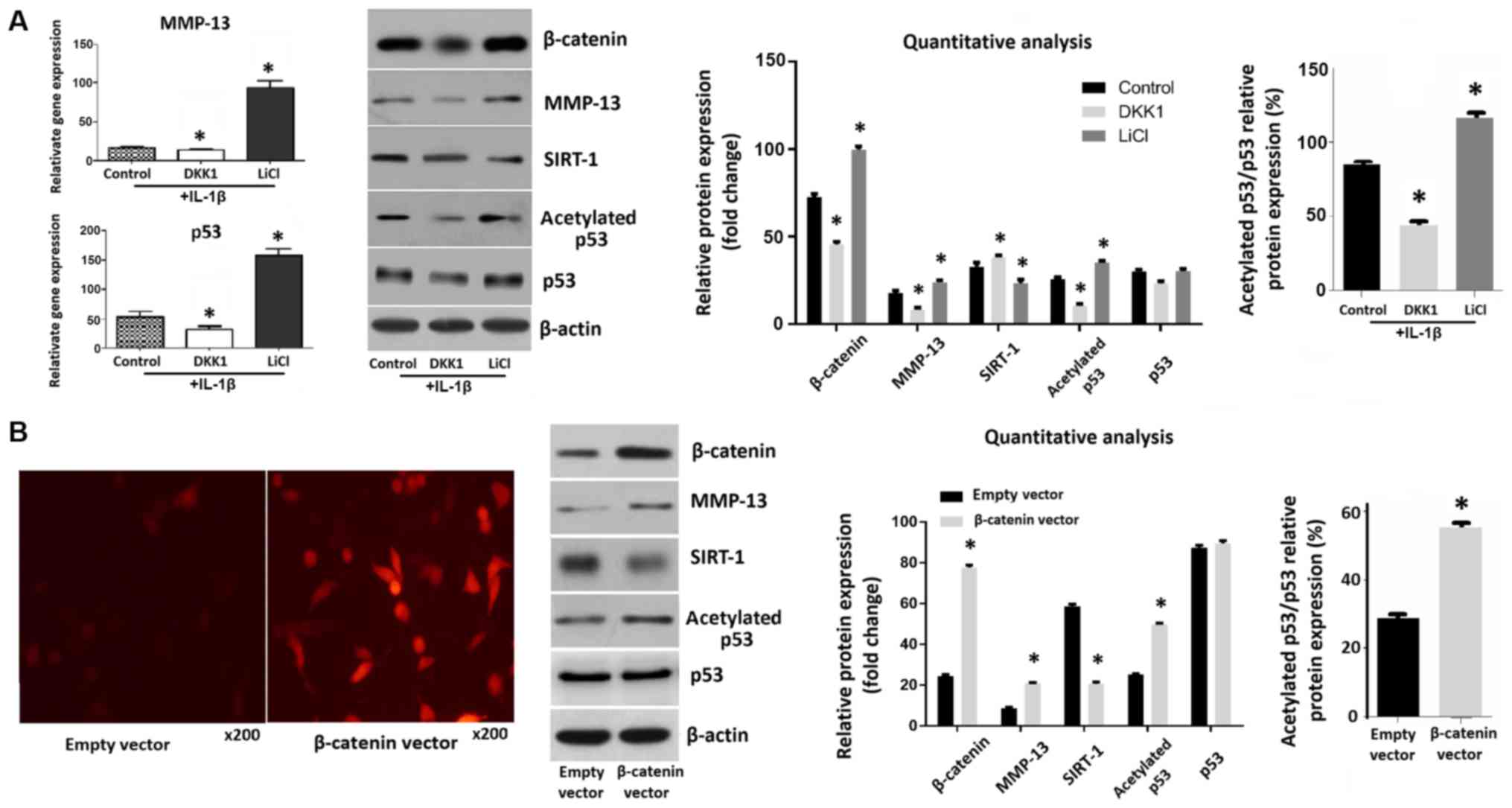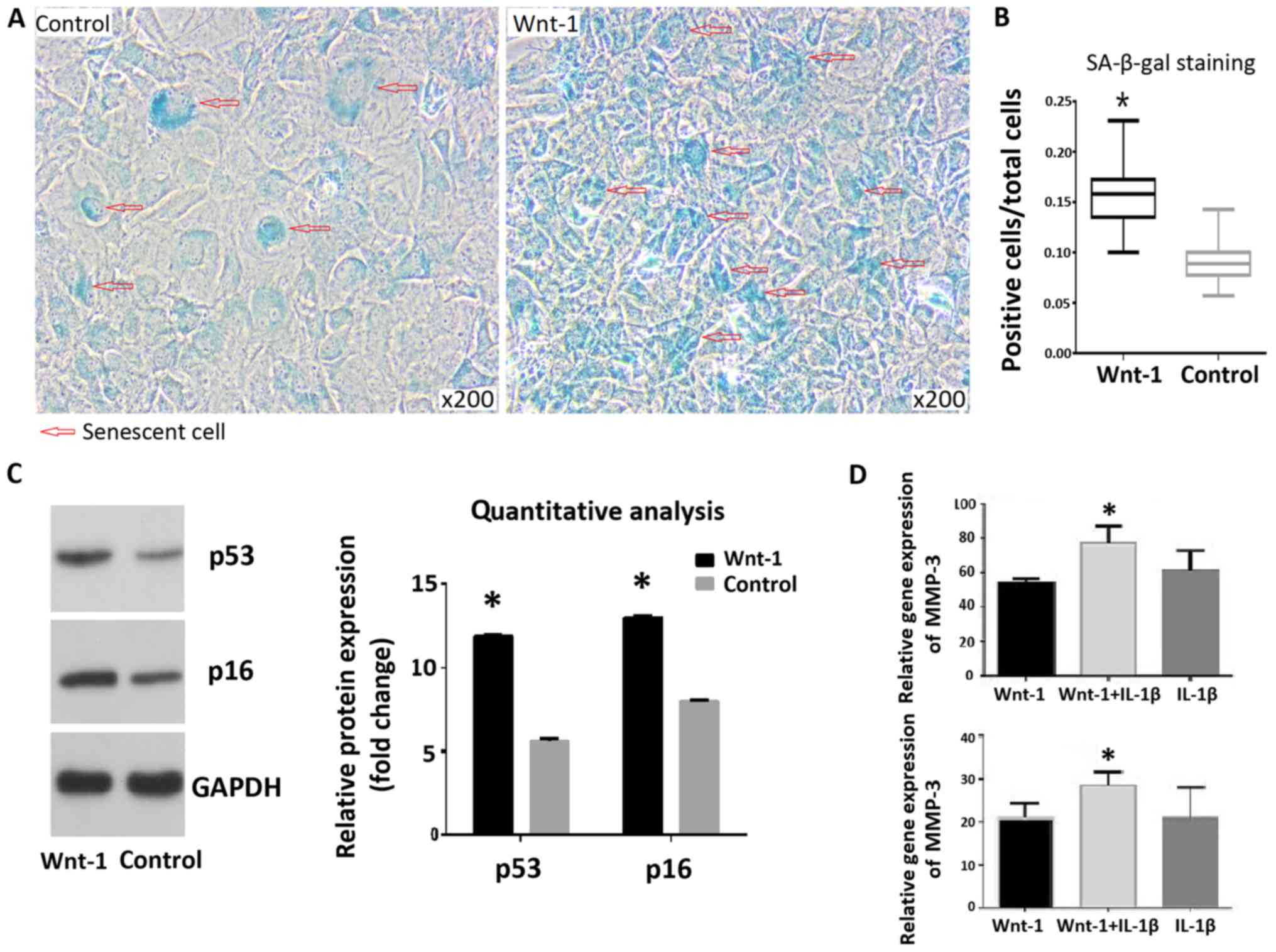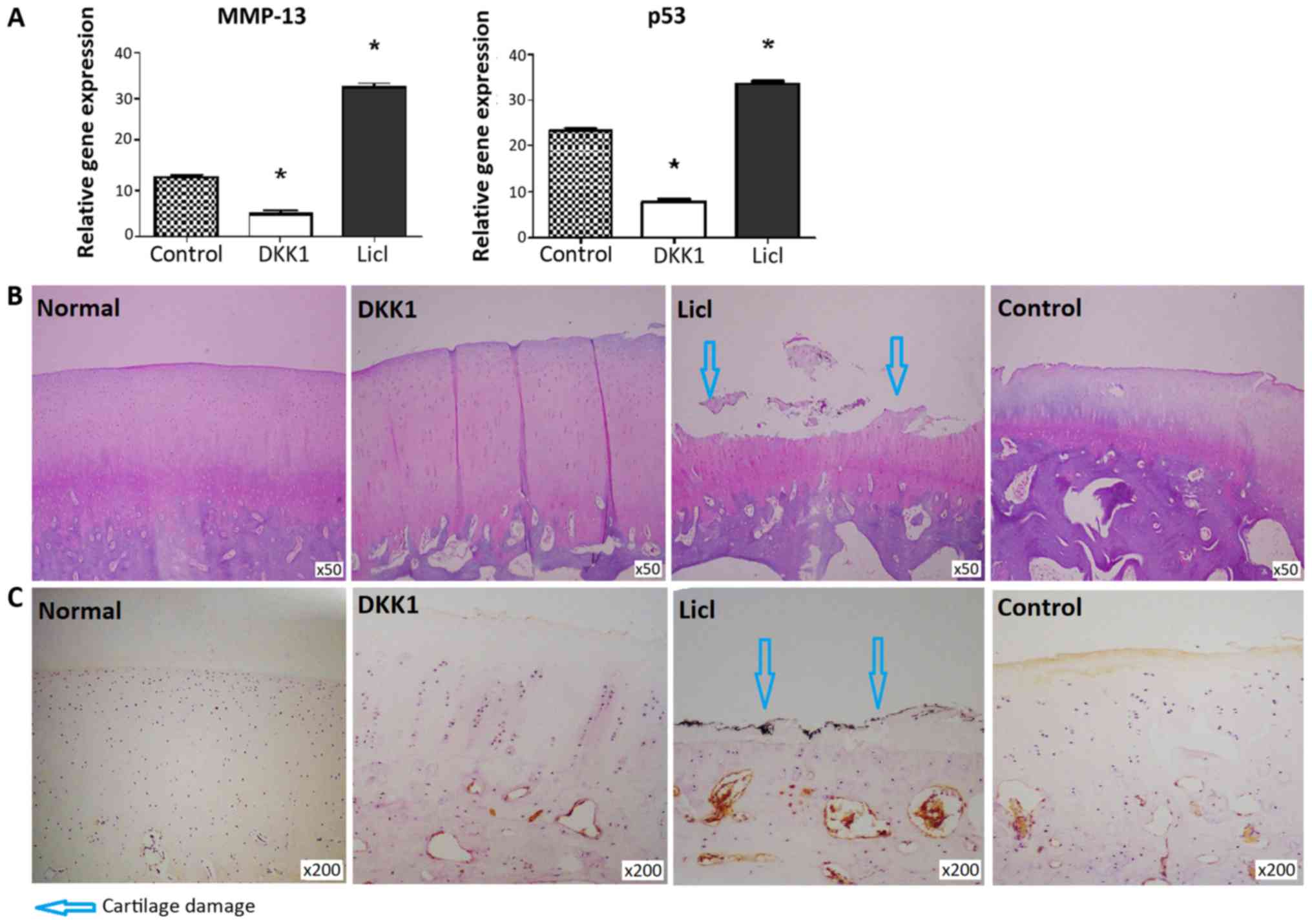|
1
|
Garstang SV and Stitik TP: Osteoarthritis:
Epidemiology, risk factors, and pathophysiology. Am J Phys Med
Rehabil. 85 (11 Suppl):S2–S11; quiz S12-S14. 2006.PubMed/NCBI View Article : Google Scholar
|
|
2
|
Arden N and Nevitt MC: Osteoarthritis:
Epidemiology. Best Pract Res Clin Rheumatol. 20:3–25.
2006.PubMed/NCBI View Article : Google Scholar
|
|
3
|
Vinatier C, Domínguez E, Guicheux J and
Caramés B: Role of the inflammation-autophagy-senescence
integrative network in osteoarthritis. Front Physiol.
25(706)2018.PubMed/NCBI View Article : Google Scholar
|
|
4
|
Erusalimsky JD and Kurz DJ: Cellular
senescence in vivo: Its relevance in ageing and cardiovascular
disease. Exp Gerontol. 40:634–642. 2005.PubMed/NCBI View Article : Google Scholar
|
|
5
|
McCulloch K, Litherland GJ and Rai TS:
Cellular senescence in osteoarthritis pathology. Aging Cell.
16:210–218. 2017.PubMed/NCBI View Article : Google Scholar
|
|
6
|
Price JS, Waters JG, Darrah C, Pennington
C, Edwards DR, Donell ST and Clark IM: The role of chondrocyte
senescence in osteoarthritis. Aging Cell. 1:57–65. 2002.PubMed/NCBI View Article : Google Scholar
|
|
7
|
Xu M, Bradley EW, Weivoda MM, Hwang SM,
Pirtskhalava T, Decklever T, Curran GL, Ogrodnik M, Jurk D, Johnson
KO, et al: Transplanted senescent cells induce an
osteoarthritis-like condition in mice. J Gerontol A Biol Sci Med
Sci. 72:780–785. 2017.PubMed/NCBI View Article : Google Scholar
|
|
8
|
Jeon OH, Kim C, Laberge RM, Demaria M,
Rathod S, Vasserot AP, Chung JW, Kim DH, Poon Y, David N, et al:
Local clearance of senescent cells attenuates the development of
post-traumatic osteoarthritis and creates a pro-regenerative
environment. Nat Med. 23:775–781. 2017.PubMed/NCBI View
Article : Google Scholar
|
|
9
|
Johnson ML and Kamel MA: The wnt signaling
pathway and bone metabolism. Curr Opin Rheumatol. 19:376–382.
2007.PubMed/NCBI View Article : Google Scholar
|
|
10
|
Schett G, Zwerina J and David JP: The role
of wnt proteins in arthritis. Nat Clin Pract Rheumatol. 4:473–480.
2008.PubMed/NCBI View Article : Google Scholar
|
|
11
|
Corr M: Wnt-beta-catenin signaling in the
pathogenesis of osteoarthritis. Nat Clin Pract Rheumatol.
4:550–556. 2008.PubMed/NCBI View Article : Google Scholar
|
|
12
|
Yuasa T, Otani T, Koike T, Iwamoto M and
Enomoto-Iwamoto M: Wnt/beta-catenin signaling stimulates matrix
catabolic genes and activity in articular chondrocytes: Its
possible role in joint degeneration. Lab Invest. 88:264–274.
2008.PubMed/NCBI View Article : Google Scholar
|
|
13
|
Tamamura Y, Otani T, Kanatani N, Koyama E,
Kitagaki J, Komori T, Yamada Y, Costantini F, Wakisaka S, Pacifici
M, et al: Developmental regulation of Wnt/beta-catenin signals is
required for growth plate assembly, cartilage integrity, and
endochondral ossification. J Biol Chem. 13:19185–19195.
2005.PubMed/NCBI View Article : Google Scholar
|
|
14
|
Zhu M, Tang D, Wu Q, Hao S, Chen M, Xie C,
Rosier RN, O'Keefe RJ, Zuscik M and Chen D: Activation of
beta-catenin signaling in articular chondrocytes leads to
osteoarthritis-like phenotype in adult beta-catenin conditional
activation mice. J Bone Miner Res. 24:12–21. 2009.PubMed/NCBI View Article : Google Scholar
|
|
15
|
Clevers H: Wnt/beta-catenin signaling in
development and disease. Cell. 3:469–480. 2006.PubMed/NCBI View Article : Google Scholar
|
|
16
|
Gregory CA, Singh H, Perry AS and Prockop
DJ: The Wnt signaling inhibitor dickkopf-1 is required for reentry
into the cell cycle of human adult stem cells from bone marrow. J
Biol Chem. 278:28067–28078. 2003.PubMed/NCBI View Article : Google Scholar
|
|
17
|
Hiyama A, Sakai D, Risbud MV, Tanaka M,
Arai F, Abe K and Mochida J: Enhancement of intervertebral disc
cell senescence by WNT/β-catenin signaling-induced matrix
metalloproteinase expression. Arthritis Rheum. 62:3036–3047.
2010.PubMed/NCBI View Article : Google Scholar
|
|
18
|
Song P, Zheng JX, Liu JZ, Xu J, Wu LY, Liu
C, Zhu Q and Wang Y: Effect of the Wnt1/β-catenin signalling
pathway on human embryonic pulmonary fibroblasts. Mol Med Rep.
10:1030–1036. 2014.
|
|
19
|
Li WJ, Tang LP, Xiong Y, Chen WP, Zhou XD,
Ding QH and Wu LD: A possible mechanism in DHEA-mediated protection
against osteoarthritis. Steroids. 89:20–26. 2014.PubMed/NCBI View Article : Google Scholar
|
|
20
|
Livak KJ and Schmittgen TD: Analysis of
relative gene expression data using real-time quantitative PCR and
the 2(-Delta Delta C(T)) method. Methods. 25:402–408.
2001.PubMed/NCBI View Article : Google Scholar
|
|
21
|
Mankin HJ, Dorfman H, Lippiello L and
Zarins A: Biochemical and metabolic abnormalities in articular
cartilage from osteo-arthritic human hips. II. Correlation of
morphology with biochemical and metabolic data. J Bone Joint Surg
Am. 53:523–537. 1971.PubMed/NCBI
|
|
22
|
Wojdasiewicz P, Poniatowski ŁA and
Szukiewicz D: The role of inflammatory and anti-inflammatory
cytokines in the pathogenesis of osteoarthritis. Mediators Inflamm.
2014(561459)2014.PubMed/NCBI View Article : Google Scholar
|
|
23
|
Heinecke LF, Grzanna MW, Au AY, Mochal CA,
Rashmir-Raven A and Frondoza CG: Inhibition of cyclooxygenase-2
expression and prostaglandin E2 production in chondrocytes by
avocado soybean unsaponifiables and epigallocatechin gallate.
Osteoarthritis Cartilage. 18:220–227. 2010.PubMed/NCBI View Article : Google Scholar
|
|
24
|
Mitchell PG, Magna HA, Reeves LM,
Lopresti-Morrow LL, Yocum SA, Rosner PJ, Geoghegan KF and Hambor
JE: Cloning, expression, and type II collagenolytic activity of
matrix metalloproteinase-13 from human osteoarthritic cartilage. J
Clin Invest. 1:761–768. 1996.PubMed/NCBI View Article : Google Scholar
|
|
25
|
Ye X, Zerlanko B, Kennedy A, Banumathy G,
Zhang R and Adams PD: Downregulation of wnt signaling is a trigger
for formation of facultative heterochromatin and onset of cell
senescence in primary human cells. Mol Cell. 27:183–196.
2007.PubMed/NCBI View Article : Google Scholar
|
|
26
|
Campisi J: Senescent cells, tumor
suppression, and organismal aging: Good citizens, bad neighbors.
Cell. 120:513–522. 2005.PubMed/NCBI View Article : Google Scholar
|
|
27
|
Reya T and Clevers H: Wnt signalling in
stem cells and cancer. Nature. 14:843–850. 2005.PubMed/NCBI View Article : Google Scholar
|
|
28
|
Liu H, Fergusson MM, Castilho RM, Liu J,
Cao L, Chen J, Malide D, Rovira II, Schimel D, Kuo CJ, et al:
Augmented Wnt signaling in a mammalian model of accelerated aging.
Science. 10:803–806. 2007.PubMed/NCBI View Article : Google Scholar
|
|
29
|
Ferbeyre G, de Stanchina E, Lin AW,
Querido E, McCurrach ME, Hannon GJ and Lowe SW: Oncogenic ras and
p53 cooperate to induce cellular senescence. Mol Cell Biol.
22:3497–3508. 2002.PubMed/NCBI View Article : Google Scholar
|
|
30
|
Lee SW, Fang L, Igarashi M, Ouchi T, Lu KP
and Aaronson SA: Sustained activation of Ras/Raf/mitogen-activated
protein kinase cascade by the tumor suppressor p53. Proc Natl Acad
Sci USA. 18:8302–8305. 2000.PubMed/NCBI View Article : Google Scholar
|
|
31
|
Narita M, Nũnez S, Heard E, Narita M, Lin
AW, Hearn SA, Spector DL, Hannon GJ and Lowe SW: Rb-mediated
heterochromatin formation and silencing of E2F target genes during
cellular senescence. Cell. 13:703–716. 2003.PubMed/NCBI View Article : Google Scholar
|
|
32
|
Sasaki T, Maier B, Bartke A and Scrable H:
Progressive loss of SIRT1 with cell cycle withdrawal. Aging Cell.
5:413–4122. 2006.PubMed/NCBI View Article : Google Scholar
|
|
33
|
Langley E, Pearson M, Faretta M, Bauer UM,
Frye RA, Minucci S, Pelicci PG and Kouzarides T: Human SIR2
deacetylates p53 and antagonizes PML/p53-induced cellular
senescence. EMBO J. 15:2383–2396. 2002.PubMed/NCBI View Article : Google Scholar
|
|
34
|
Vigneron A and Vousden KH: p53, ROS and
senescence in the control of aging. Aging (Albany NY). 2:471–474.
2010.PubMed/NCBI View Article : Google Scholar
|

















